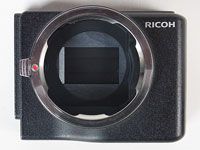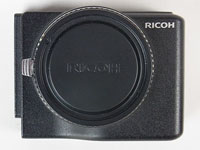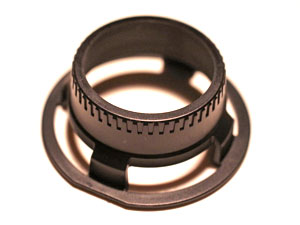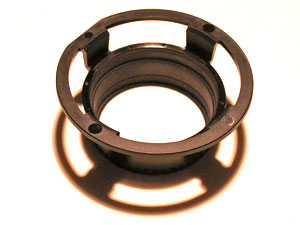Ricoh GXR: Expansion Unit A12 M-Mount
Introduction to the A12 M-Mount Expansion Unit | Using Lenses | Experiences | Conclusions | Links
Archive
On this page, I collect information about the Ricoh GXR A12 M-mount expansion unit that allows to use manual lenses with the Leica M bayonet on the Ricoh GXR.
Introduction to the A12 M-Mount Expansion Unit
A lot had been speculated in the photo forums about the Ricoh GXR M-mount expansion unit, a unit without a lens that features a Leica M bayonet and an APS-C size sensor (CMOS, total pixels: approx. 12.9 million, effective pixels approx. 12.3 million - more or less the same as for the two other A12 units). The unit appeared on the roadmap that Ricoh secretly revealed at Photokina 2010, was officially announced by Ricoh in August 2011, and eventually hit the market on September 9, 2011 - albeit in small quantities only.
 |
 |
Photo: Ricoh A12 M-mount expansion unit
The expansion unit has features that are meant to support manual focusing as well as a wide range of lenses with Leica M bayonet:
- Focus assist view for manual focusing* using two approaches: enhancement of edges (B&W) or contrasts (color)
- Improved screen enlargement (in two variants - section and full screen, which offers better image quality)
- User-defined distortion, vignetting, and corner color correction - recordable for multiple lenses (can be recorded on the SD card)
*) With other units, the focus assist can also be used with AF, which does not make much sense in my opinion...
In addition, the unit has two shutters, a mechanical and an electronic one:
- Mechanical shutter: 1/4000 - 180s
- Electronic shutter: 1/8000th - 1s (not suitable for moving objects)
The electronic shutter is probably meant as a competition to the silent Leica shutters. It has to be selected in the scene modes and is not suitable for moving objects (it can be used for achieving special effects, though...).
Another specialty of the M-mount unit is that is does not have an AA filter, resulting in much more detail as many posters report in the forums...
This unit allows to capture videos in HD 720p format (no AF).
Using Lenses
The A12 M-mount expansion unit accepts manual lenses with Leica M bayonet (or M-mount). There is no mechanical or electric coupling between lens and the body. Other manual lenses can be used with adapters. For example, Novoflex offers a wide range of such adapters (adapter finder; ditto in German), however, with a steep price tag. The "number one" choice for adapter is probably an adapter for using M39 Leica lenses (for example, older Leitz, Voigtländer, or Zorki lenses) with the unit.
(In)compatible Lenses
Ricoh publishes a list of approved lenses at the bottom of their M-mount unit page (Mounting Check Results for Each Lens). In addition, they supply a "check device" with the M-mount unit that you can use to check whether the rear part of a lens protrudes too far so that it might damage the sensor. There is also a list of (in)compatible lenses at Ricohforum that was continually updated for quite some time and is much more useful than Ricoh's list.
 |
 |
Photos: The check device that Ricoh supplies with the M-mount expansion unit
Among the manufacturers who offer Leica M lenses are:
- Leitz (Leica) - current and old models
- Zeiss - current and old models
- Voigtländer (Cosina) - current and old models
- Ricoh - no longer manufactured
- Minolta - no longer manufactured
- Zorki - M39 only
My M-Mount Lenses
For more information on the M-mount lenses that I purchased, start at page My Equipment Related to the M-Mount Expansion Unit.
Experiences
With its APS-C sensor, the A12 M-mount expansion unit offers an image quality comparable to that of DSLRs - just like the preceding A12-50 and A12-28 camera units, with which it (nearly) shares the sensor. Like with its predecessors, image quality is hampered by visible banding in night scenes, which is caused by the CMOS sensor. However, I did not check that in detail yet.
Many forum posters praise the lack of an AA filter, resulting in finer details than its A12 companions and many other APS-C cameras with such a filter can deliver. Of course, this is confounded with the lenses that are being used on the unit. Many M-mount lenses are old designs or based on old designs, which exhibit quite different image characteristics than new ones.
For many photographers, the A12 M-mount expansion unit opened up a whole new field for experimentation and they had a lot of fun with this. Some adopted it as a "cheap," but high-quality Leica substitute that allowed them to experiment with manual lenses. Others used it as an additional body for existing Leica gear. Many, like me, moved thereby into new terrain, buying one M-mount lens after the other... My current lens count is eight, including an M39 lens that can be used with an LTM adapter (see page My Equipment Related to the M-Mount Expansion Unit).
After a while, however, many users who had "jumped on the band wagon" returned to their AF lenses, because they found using manual lenses too tedious and/or difficult. I stopped using the M-mount expansion unit (more or less) after I had purchased the A16 24-85 unit, which was a more flexible and lighter solution than carrying around a couple of heavy M-mount lenses, particularly on vacations. And this trend continued when I bought the Leica X Vario, which also threw the A16 "out of business." In June 2014, I revived my interest in my M-mount lens collection a little bit and found out that they offer my the chance to take shots with a tele perspective that my other cameras do not offer. Let's see whether this was just a "straw fire"...
Nevertheless, reviewer Sean Reid maintains that, thanks to the use of special micro lenses on the sensor, the A12 M-mount expansion unit still is the best non-Leica solution to using M-mount lenses (as of mid-2014) - and, according to him, it also fares better than the new 16 Megapixels Leica T, which offers an M-mount adapter for using M-mount lenses.
You can find more information on my experiences with this unit and the lenses that I have bought for it, including an FAQ, in the Links section below.
Conclusions
The GXR A12 M-mount expansion unit opened up a whole new field for experimentation. This may be one of the reasons, why the units has so eagerly been adopted - and, of course, also as a "cheap", but high-quality Leica replacement or as an additional body for existing Leica gear. However, many adopters soon gave up and returned to their AF lenses...
With its APS-C sensor, the A12 M-mount expansion unit offers an image quality comparable to that of DSLRs - just like the preceding A12-50 and A12-28 camera units, with which it (nearly) shares the sensor. Like with its predecessors, image quality is hampered by visible banding in night scenes, which is caused by the CMOS sensor.
Lacking an AA filter, the M-mount expansion unit delivers finer details than its A12 companions and many other APS-C cameras with such a filter. According to reviewer Sean Reid, due to the lens of special micro lenses on the sensor, the A12 M-mount expansion unit still is the best non-Leica solution to using M-mount lenses (as of mid-2014) - and, according to him, it also fares better than the new Leica T with its 16 Megapixels sensor when used with M-mount lenses.
Links
Ricoh Links
- Technical data: ricoh.com/r_dc/gxr/specs.html#14
- Description (includes a list of (in)compatible lenses): ricoh.com/r_dc/gxr/unit5.html
More Links
- DPR preview: www.dpreview.com/previews/ricohgxrmounta12
- List of (in)compatible lenses at Ricohforum: ricohforum.com/phpbb/viewtopic.php?f=63&t=6881
- Novoflex adpter finder (ditto in German)
For more links related to the Ricoh GXR M-mount expansion unit, see page M-Mount Links.
| 19.11.2020 |